Choosing a Gaming CPU at 1440p: Adding in Haswell
by Ian Cutress on June 4, 2013 10:00 AM ESTCPU Benchmarks
Point Calculations - 3D Movement Algorithm Test
The algorithms in 3DPM employ both uniform random number generation or normal distribution random number generation, and vary in amounts of trigonometric operations, conditional statements, generation and rejection, fused operations, etc. The benchmark runs through six algorithms for a specified number of particles and steps, and calculates the speed of each algorithm, then sums them all for a final score. This is an example of a real world situation that a computational scientist may find themselves in, rather than a pure synthetic benchmark. The benchmark is also parallel between particles simulated, and we test the single threaded performance as well as the multi-threaded performance.
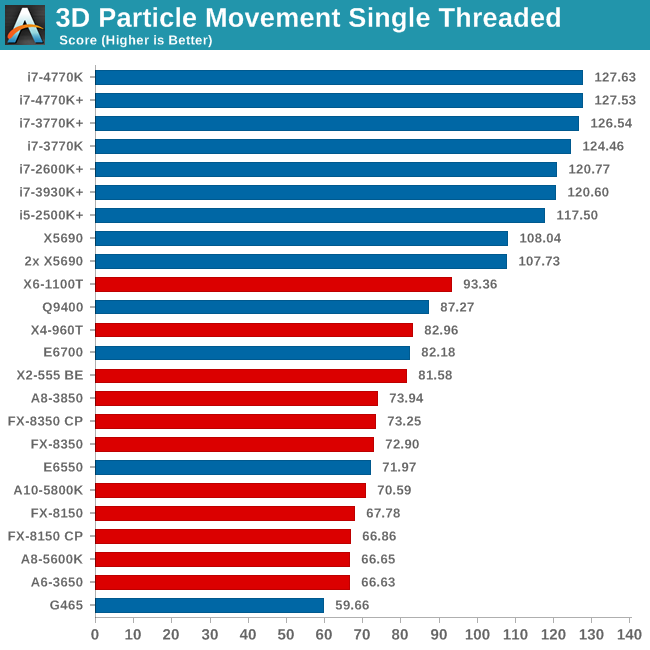
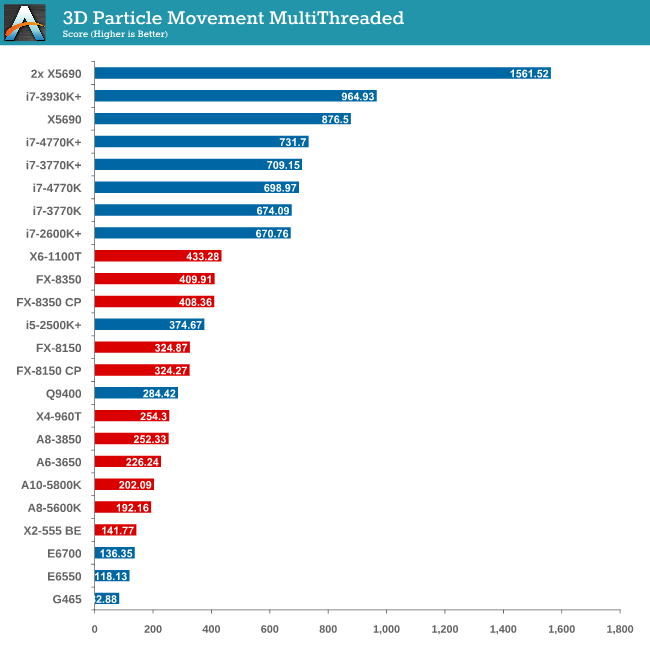
As mentioned in previous reviews, this benchmark is written how most people would tackle the situation – using floating point numbers. This is also where Intel excels, compared to AMD’s decision to move more towards INT ops (such as hashing), which is typically linked to optimized code or normal OS behavior.
The 4770K comes in top in single threaded performance, showcasing the IPC gains of the new architecture. This is also shown in multithreaded tests with MCT both off and on.
Compression - WinRAR x64 3.93 + WinRAR 4.2
With 64-bit WinRAR, we compress the set of files used in our motherboard USB speed tests. WinRAR x64 3.93 attempts to use multithreading when possible and provides a good test for when a system has variable threaded load. WinRAR 4.2 does this a lot better! If a system has multiple speeds to invoke at different loading, the switching between those speeds will determine how well the system will do.
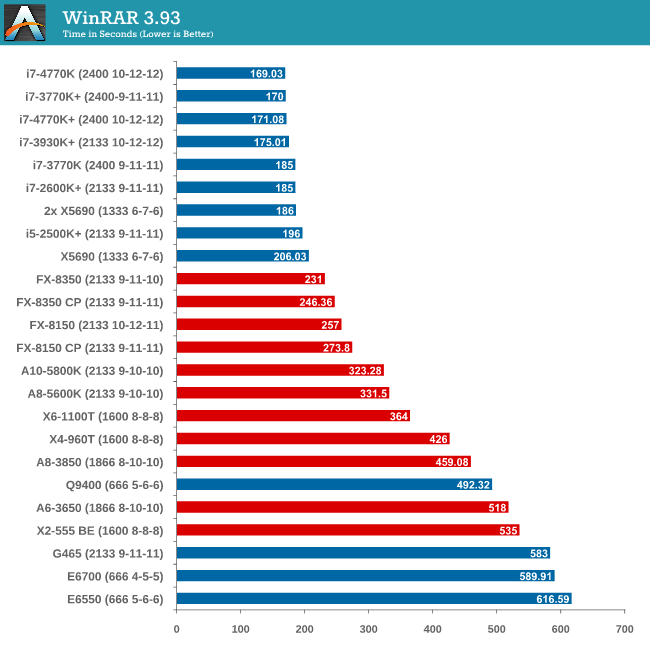
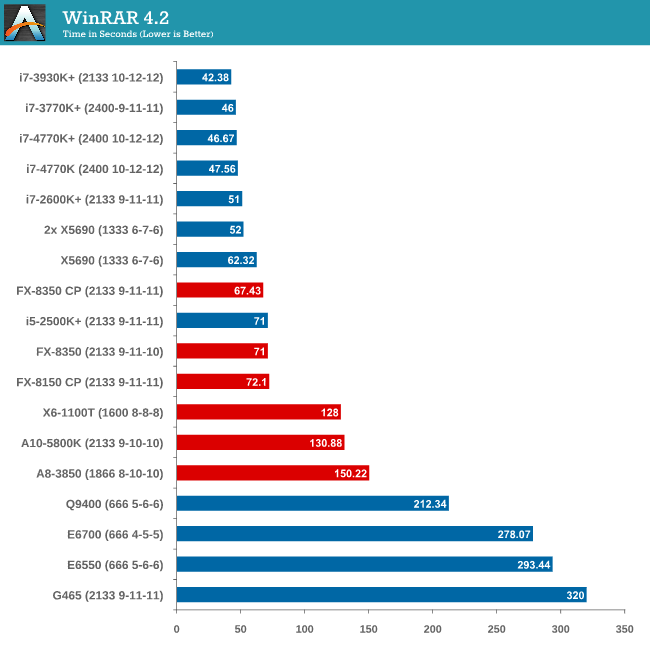
Due to the late inclusion of 4.2, our results list for it is a little smaller than I would have hoped. But it is interesting to note that with the Core Parking updates, an FX-8350 overtakes an i5-2500K with MCT.
Image Manipulation - FastStone Image Viewer 4.2
FastStone Image Viewer is a free piece of software I have been using for quite a few years now. It allows quick viewing of flat images, as well as resizing, changing color depth, adding simple text or simple filters. It also has a bulk image conversion tool, which we use here. The software currently operates only in single-thread mode, which should change in later versions of the software. For this test, we convert a series of 170 files, of various resolutions, dimensions and types (of a total size of 163MB), all to the .gif format of 640x480 dimensions.
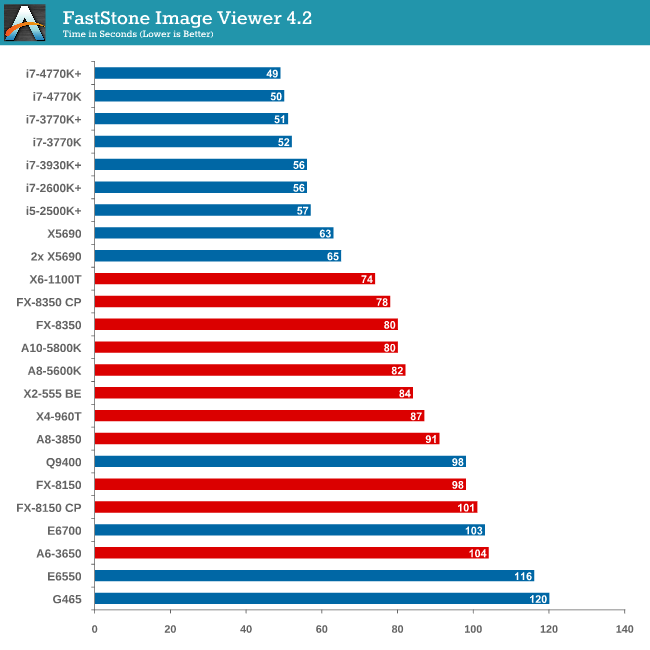
In terms of pure single thread speed, it is worth noting the X6-1100T is leading the AMD pack, and the 4770K takes the top spot. .
Video Conversion - Xilisoft Video Converter 7
With XVC, users can convert any type of normal video to any compatible format for smartphones, tablets and other devices. By default, it uses all available threads on the system, and in the presence of appropriate graphics cards, can utilize CUDA for NVIDIA GPUs as well as AMD WinAPP for AMD GPUs. For this test, we use a set of 33 HD videos, each lasting 30 seconds, and convert them from 1080p to an iPod H.264 video format using just the CPU. The time taken to convert these videos gives us our result.
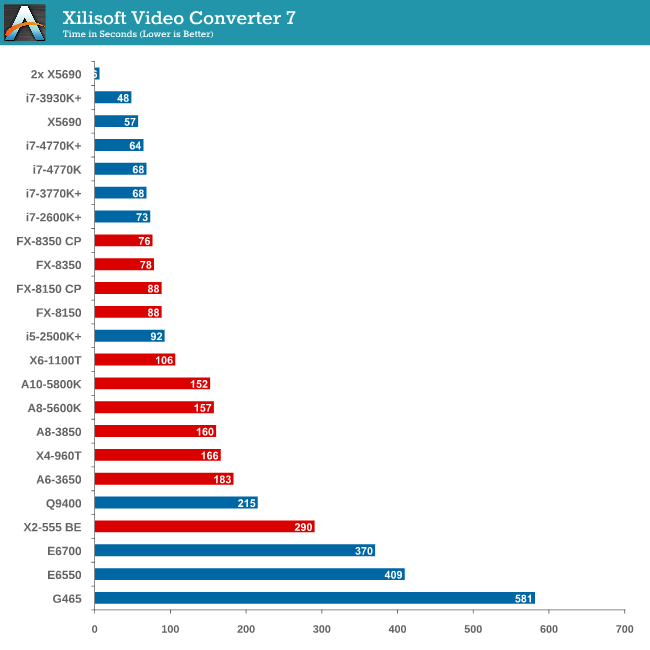
XVC is a little odd in how it arranges its multicore processing. For our set of 33 videos, it will arrange them in batches of threads – so if we take the 8 thread FX-8350, it will arrange the videos into 4 batches of 8, and then a fifth batch of one. That final batch will only have one thread assigned to it (!), and will not get a full 8 threads worth of power. This is also why the 2x X5690 finishes in 6 seconds but the normal X5690 takes longer – you would expect a halving of time moving to two CPUs but XVC arranges the batches such that there is always one at the end that only gets a single thread.
Rendering – PovRay 3.7
The Persistence of Vision RayTracer, or PovRay, is a freeware package for as the name suggests, ray tracing. It is a pure renderer, rather than modeling software, but the latest beta version contains a handy benchmark for stressing all processing threads on a platform. We have been using this test in motherboard reviews to test memory stability at various CPU speeds to good effect – if it passes the test, the IMC in the CPU is stable for a given CPU speed. As a CPU test, it runs for approximately 2-3 minutes on high end platforms.
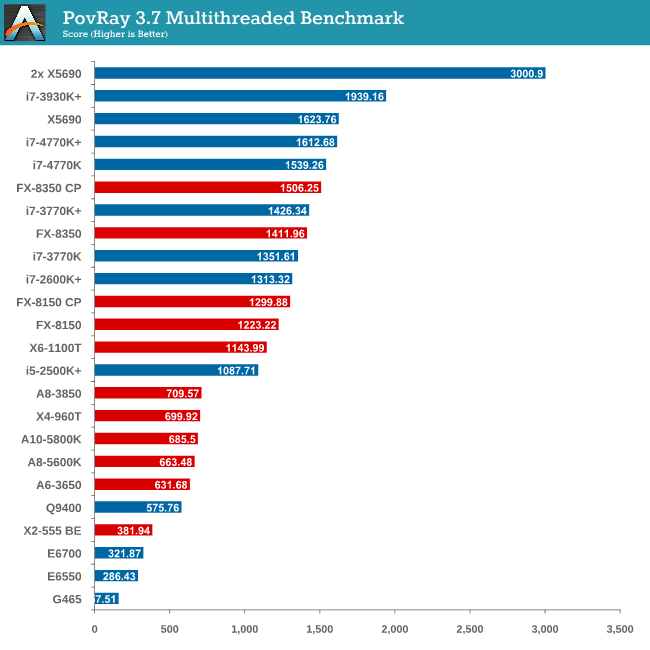
The SMP engine in PovRay is not perfect, though scaling up in CPUs gives almost a 2x effect. The results from this test are great – here we see an FX-8350 CPU below an i7-3770K (with MCT), until the Core Parking updates are applied, meaning the FX-8350 performs better! The 4770K also has a chance to flex its compute muscles, performing almost as well as the 8-core Westmere CPU.
Video Conversion - x264 HD Benchmark
The x264 HD Benchmark uses a common HD encoding tool to process an HD MPEG2 source at 1280x720 at 3963 Kbps. This test represents a standardized result which can be compared across other reviews, and is dependent on both CPU power and memory speed. The benchmark performs a 2-pass encode, and the results shown are the average of each pass performed four times.
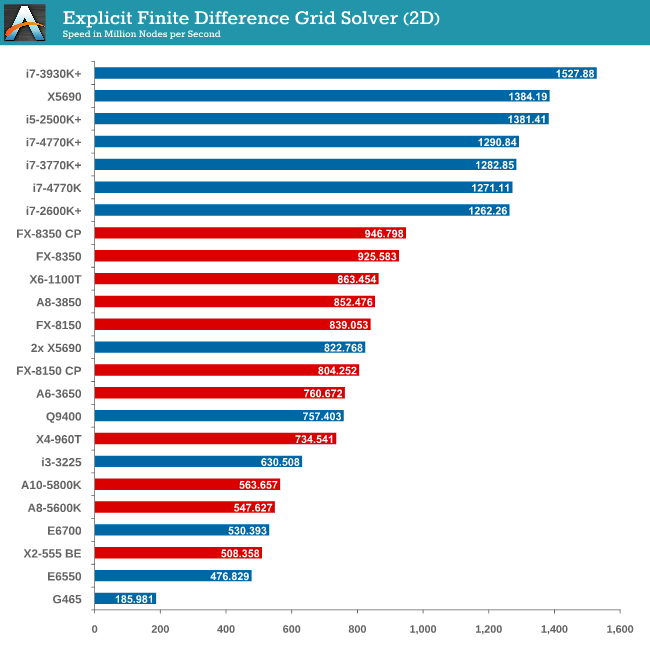
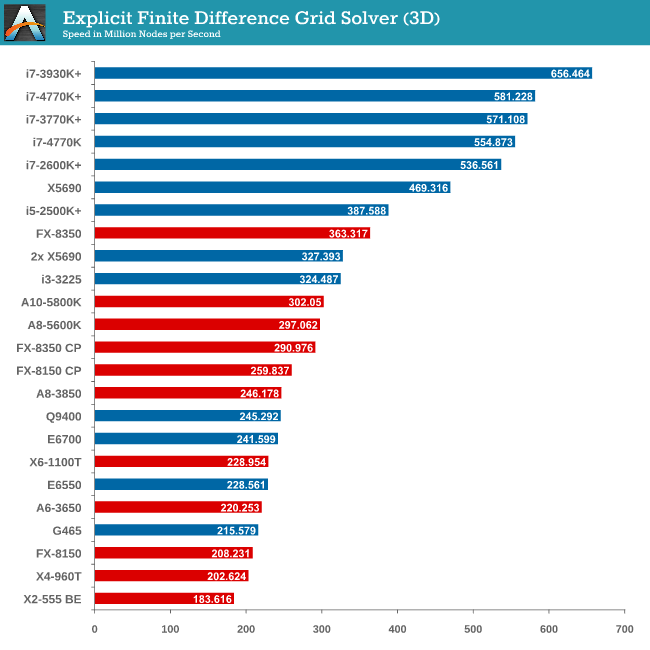
Grid Solvers - Explicit Finite Difference
For any grid of regular nodes, the simplest way to calculate the next time step is to use the values of those around it. This makes for easy mathematics and parallel simulation, as each node calculated is only dependent on the previous time step, not the nodes around it on the current calculated time step. By choosing a regular grid, we reduce the levels of memory access required for irregular grids. We test both 2D and 3D explicit finite difference simulations with 2n nodes in each dimension, using OpenMP as the threading operator in single precision. The grid is isotropic and the boundary conditions are sinks. Values are floating point, with memory cache sizes and speeds playing a part in the overall score.
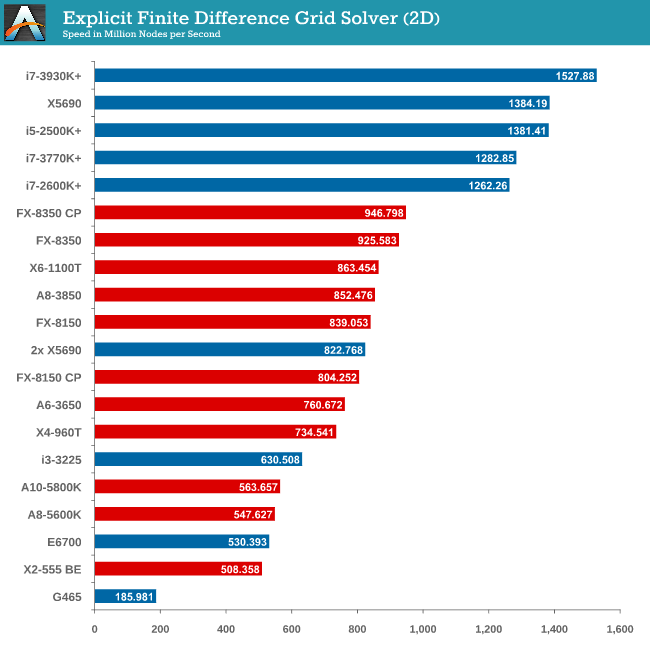
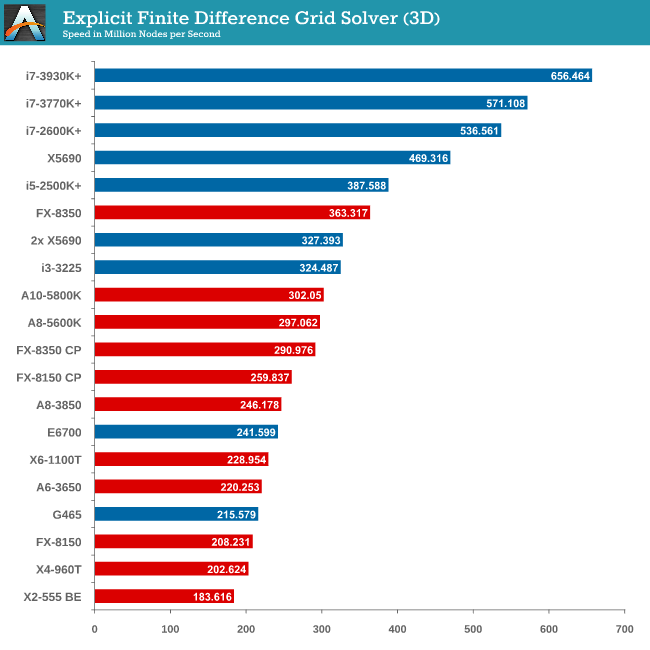
Grid solvers do love a fast processor and plenty of cache in order to store data. When moving up to 3D, it is harder to keep that data within the CPU and spending extra time coding in batches can help throughput. Our simulation takes a very naïve approach in code, using simple operations.
Grid Solvers - Implicit Finite Difference + Alternating Direction Implicit Method
The implicit method takes a different approach to the explicit method – instead of considering one unknown in the new time step to be calculated from known elements in the previous time step, we consider that an old point can influence several new points by way of simultaneous equations. This adds to the complexity of the simulation – the grid of nodes is solved as a series of rows and columns rather than points, reducing the parallel nature of the simulation by a dimension and drastically increasing the memory requirements of each thread. The upside, as noted above, is the less stringent stability rules related to time steps and grid spacing. For this we simulate a 2D grid of 2n nodes in each dimension, using OpenMP in single precision. Again our grid is isotropic with the boundaries acting as sinks. Values are floating point, with memory cache sizes and speeds playing a part in the overall score.
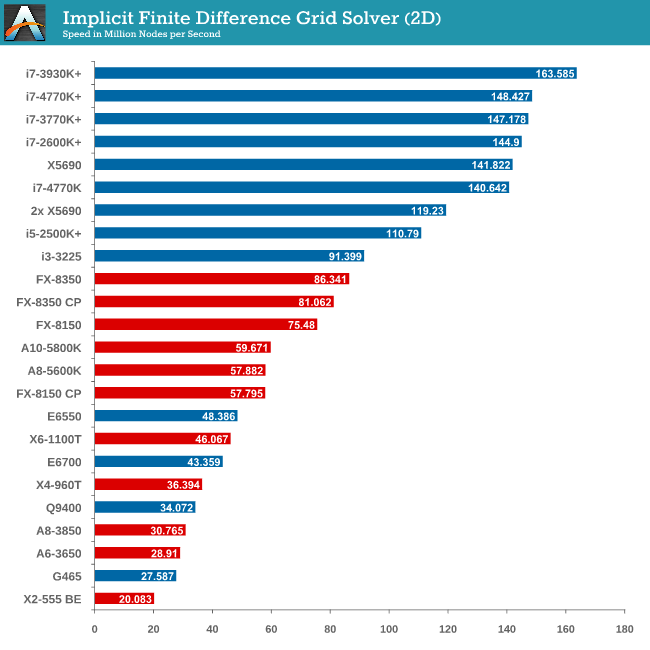
2D Implicit is harsher than an Explicit calculation – each thread needs more a lot memory, which only ever grows as the size of the simulation increases.
Point Calculations - n-Body Simulation
When a series of heavy mass elements are in space, they interact with each other through the force of gravity. Thus when a star cluster forms, the interaction of every large mass with every other large mass defines the speed at which these elements approach each other. When dealing with millions and billions of stars on such a large scale, the movement of each of these stars can be simulated through the physical theorems that describe the interactions. The benchmark detects whether the processor is SSE2 or SSE4 capable, and implements the relative code. We run a simulation of 10240 particles of equal mass - the output for this code is in terms of GFLOPs, and the result recorded was the peak GFLOPs value.
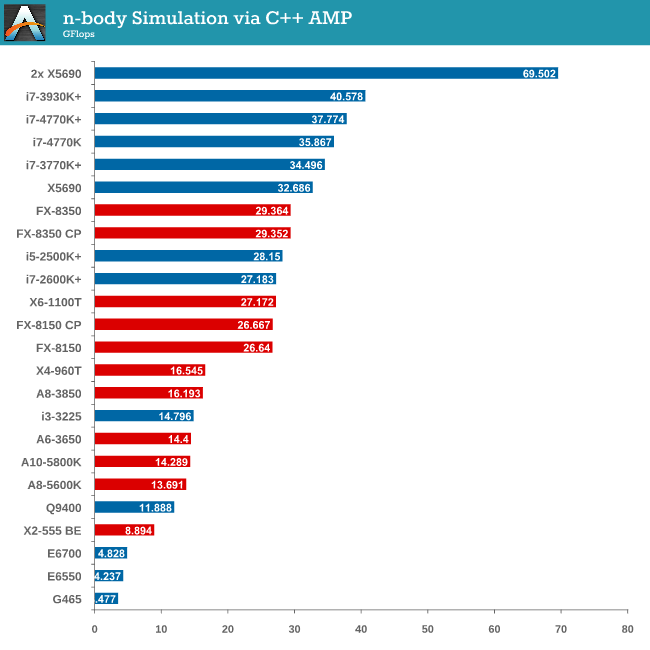
As we only look at base/SSE2/SSE4 depending on the processor (auto-detection), we don’t see full AVX numbers in terms of FLOPs.










116 Comments
View All Comments
Mobilus - Tuesday, June 4, 2013 - link
The problem isn't Haswell, the problem is the mainboard. You would need a mainboard that supports dual-link and at least with the older generations that feature wasn't implemented. Unless the usual suspects changed that with their new offerings, you will have to use a displayport to dvi adapter to get that resolution without a dedicated card (hdmi on mainboards is usually restricted to 1080p as well, unless... see above).K_Space - Tuesday, June 4, 2013 - link
I know Anandtech hasn't got to review the Richland desktop variants yet; but surely if the current recommendation is a trinity APU, surely a >10% performance increase and a lower TDP would clench it for Richland?The newly launched top end A8 6600K is £20 more than the A8 5600K.... but that's launch price.
MarcVenice - Tuesday, June 4, 2013 - link
Please, for the love of god, add a game like Crysis 3 or Far Cry 3. Your current games are all very old, and you will see a bigger difference in newer games.garrun - Tuesday, June 4, 2013 - link
Agree with request for Crysis 3. It has enough options to deliver a great visual experience and GPU beating, and it also scales well to multi-monitor resolutions for testing at extremes.BrightCandle - Tuesday, June 4, 2013 - link
gamegpu.ru have done a lot of testing on all games with a variety of CPUs. Anandtech's choice of games actually edge cases. Once you start looking at a wider list of games (Just do a few CPUs but lots of games) you'll see a much bigger trend of performance difference especially in a lot of the non AAA titles. Around 50% of games show a preference for 3930k's at this point over a 2600k, so more multithreading is start to appear but you need to test a lot more games or you wont catch that trend and instead come to a misleading conclusion.ninjaquick - Tuesday, June 4, 2013 - link
I am not sure that the CPU is used any more in more recent games. This is a CPU test, and testing older games that are known to be CPU dependent is a must.Moving forward, with the next gen consoles that is, testing the absolute newest multiplatform games will be a bit more relevant. However, even Farcry 3 and Crysis 3 are mostly GPU bound, so there will be little to no difference in performance by changing the CPUs out.
superjim - Tuesday, June 4, 2013 - link
Was thinking the same. Tomb Raider, BF3, Crysis 3, hell even Warhead would be good.garrun - Tuesday, June 4, 2013 - link
I think Supreme Commander or Supreme Commander 2 would make an excellent CPU demo. Those games have been, and remain CPU limited in a way no other games are, and for good reasons (complexity, AI, unit count), rather than poor coding. A good way to do this is to record a complex 8 player game against AI and then play it back at max speed, timing the playback. That benchmark responds pretty much 1:1 with clock speed increases and also has a direct improvement effect on gameplay when dealing with large, complex battles with thousands of units on map. The upcoming Planetary Annihilation should also be a contender for this, but isn't currently in a useful state for benchmarking.Traciatim - Tuesday, June 4, 2013 - link
I kind of hope Planetary Annihilation will have both server and client benchmarks available, since this seems like it would be a pretty amazing platform for benchmarking.IanCutress - Tuesday, June 4, 2013 - link
Interesting suggestion - is SupCom2 still being updated for performance in drivers? Does playback come out with the time automatically or is it something I'll have to try and code with a batch file. Please email me with details if you would like, I've never touched SupCom2 before.Ian